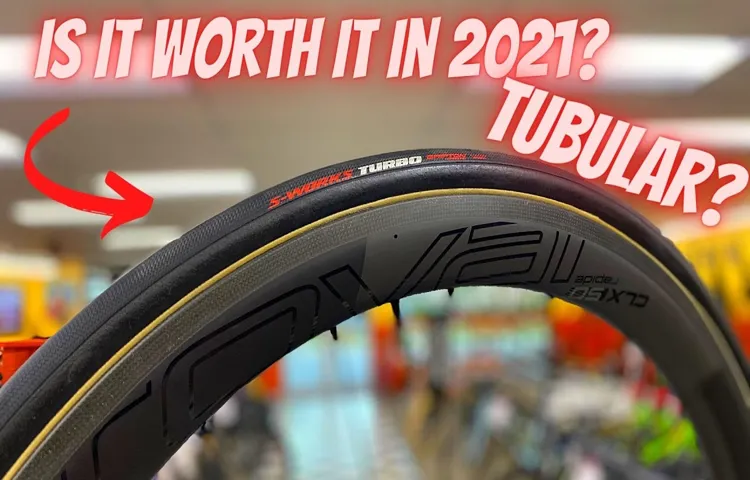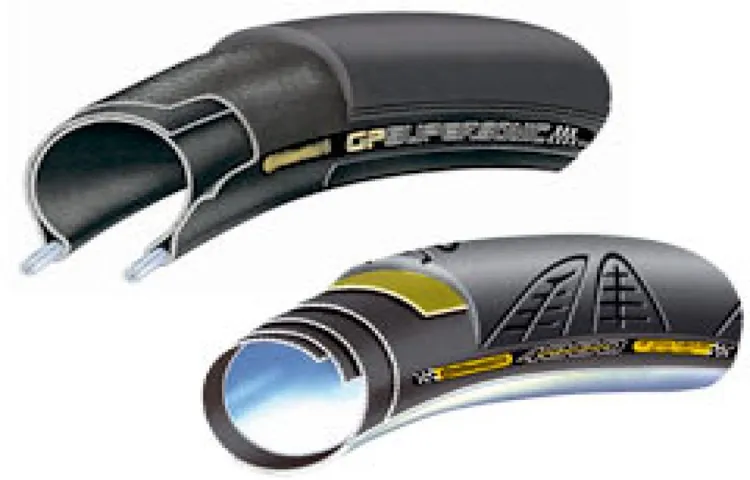Imagine gliding effortlessly on your bike, feeling the wind in your face as you speed down the road or trail. Tubular tires can help you achieve that dream, but what exactly are these specialized tires and how can they improve your ride? In this blog post, we will explore all you need to know about tubular tires and how they can take your cycling to the next level. From understanding the anatomy of a tubular tire to the benefits and drawbacks of this tire type, we will cover it all.
So, fasten your helmet, and let’s dive into the world of tubular tires together!
Table of Contents
Introduction
Have you ever heard of a tubular tire? If you’re a cycling enthusiast, chances are you’re familiar with this type of tire, but if you’re new to the sport, you might be wondering what all the fuss is about. Essentially, a tubular tire is a type of bicycle tire that’s constructed differently than most other tires. Rather than having a separate inner tube that’s held in place by the tire itself, a tubular tire is a one-piece unit that’s glued directly to the rim.
This creates a strong bond between the tire and rim, improving the overall handling and performance of the bike. While they require a bit more maintenance and don’t offer as much versatility as other tires, many avid cyclists swear by tubulars for their unbeatable ride quality and durability.
– Explanation of tubular tires
Tubular tires are a popular choice among road cyclists due to their unique design. Unlike traditional clincher tires which rely on an inner tube to hold the air, tubular tires are made by sewing the tire casing around the inner tube. This creates a seamless, round tire without any edge that could potentially cause a pinch flat.
Additionally, tubular tires are known for their ability to offer a smoother ride with more traction due to their higher air pressure and the lack of a bead hook. However, mounting and repairing tubular tires can be more difficult and time-consuming than clinchers, requiring a specific glue or tape to hold them in place on the rim. Nonetheless, for those willing to invest the time and effort, tubular tires can provide a unique riding experience with improved performance.

– Comparison to other tire types
When it comes to comparing different types of tires, there are a few things to consider. While there are many options on the market, each has its benefits and drawbacks. For example, all-season tires are versatile and can handle most weather conditions, but they are not as durable as some other types.
On the other hand, winter tires are excellent for cold and icy conditions, but they only perform well in those specific situations. Additionally, performance tires prioritize speed and handling but may not provide the same level of comfort as other options. Ultimately, the best tire for you will depend on your driving needs and preferences.
It is essential to weigh the pros and cons of each type before making a decision. However, one thing is for sure, no matter what type of tire you choose, it is crucial to invest in a high-quality option that is properly maintained to ensure optimal performance and safety on the road. The keyword used organically in this blog section is “comparing different types of tires.
“
Design and Construction
A tubular tire, also known as a sew-up tire, is a type of bike tire designed for racing. It consists of an inflated inner tube wrapped in a casing made of a single piece of fabric. Unlike traditional clincher tires, the tubular tire’s casing is sewn shut, making it lighter, more supple, and less prone to pinch flats.
Additionally, tubular tires are designed to be glued onto the rim, providing a more secure and seamless connection between the tire and the wheel. While they offer many benefits in terms of performance, tubular tires require more maintenance and can be more difficult to install and repair than traditional tires. Despite this, many professional cyclists and avid racers swear by tubular tires for their superior ride quality and handling characteristics.
– Composition of a tubular tire
When it comes to the design and construction of a tubular tire, there are a few key components to consider. First, the tread is the part of the tire that comes into contact with the road or track. It is usually made from high-quality rubber and is designed to provide maximum grip and stability.
The carcass or casing is the layer that sits beneath the tread and is responsible for absorbing shocks and providing support to the tire. It is typically made from layers of cotton or silk and is what gives the tire its shape and structure. Finally, the inner tube is the air-filled chamber that sits inside the tire and is responsible for maintaining proper inflation pressure.
Overall, the design and construction of a tubular tire are carefully crafted to provide the optimal balance between speed, performance, and durability. Whether you’re a professional racer or just a recreational cyclist, investing in a quality tubular tire can make all the difference in your overall riding experience.
– How it differs from a clincher
When it comes to cycling, there are a few different types of tires to choose from. Two popular options are clincher and tubular tires. While clinchers are more frequently used, many professional racers prefer tubulars for their superior performance.
Design and construction are the main differences between these two tire types. Clinchers feature a separate tire and inner tube that fit onto the rim, while tubulars are essentially just one piece of rubber that is glued onto the rim. This seamless construction allows for a smoother ride and better handling, but it also means that tubulars can be harder to replace if they get punctured.
Additionally, tubulars tend to have a more supple feel thanks to their thin sidewalls and high-quality materials. Overall, both clinchers and tubulars have their advantages and disadvantages, so the choice ultimately comes down to personal preference and desired performance.
Advantages and Disadvantages
A tubular tire is an entirely different kind of tire than the more traditional clincher tire that most riders are used to. Instead of being open on one end, a tubular tire is essentially a completely sealed tube that is sewn shut at the bottom, enclosing the inner tube entirely. One of the main advantages of this type of tire is that they generally offer better performance in regards to lower rolling resistance.
Additionally, tubular tires often offer superior grip and handling compared to their clincher counterparts, especially when it comes to higher speeds or more aggressive riding. However, one of the main drawbacks of tubular tires is that they can be significantly more challenging to install than clinchers, as they require special techniques and adhesives to be attached to the rim. Additionally, they can be more challenging and expensive to repair if a puncture or other damage occurs.
Despite these drawbacks, many experienced cyclists swear by tubular tires for their improved performance and handling capabilities.
– Pros of using a tubular tire
Tubular tires are a popular choice among professional cyclists and serious amateurs, and for good reason. One of the most significant advantages of using tubular tires is their ability to provide a smoother and more efficient ride. Since the casing of the tire is sewn around the inner tube, it creates a uniform and round shape that reduces rolling resistance.
As a result, tubular tires tend to offer a more direct and responsive feel on the road while also providing better cornering grip. Additionally, tubular tires tend to be lighter than clincher tires, with less friction between the tube and tire casing. However, it’s worth noting that tubular tires can be challenging to install and maintain, and they require a specific type of rim.
Moreover, replacing a punctured tubular tire can be more time-consuming and complicated compared to clincher tires. Overall, tubular tires come with some excellent benefits, but their high-level performance comes at a higher cost and requires more technical expertise.
– Cons of using a tubular tire
When it comes to using tubular tires there are certainly some advantages to consider, such as their incredibly low rolling resistance and ability to offer a more comfortable ride. However, there are also a few disadvantages to take into account before making the switch. One of the main cons is the added difficulty of installing and maintaining these types of tires.
They must be glued onto the rim, which requires a bit of skill and patience. Additionally, if you encounter a flat tire while using tubulars, it can be quite a hassle to replace and repair compared to more traditional tires. Another disadvantage to consider is the expense; tubular tires are typically much more expensive than their clincher counterparts.
However, if you’re an experienced rider looking for the ultimate in performance, the benefits of using tubular tires may outweigh the negatives.
Maintenance and Repair
If you’re an avid cyclist, you may have heard of tubular tires. These are a type of tire that don’t have a traditional inner tube – instead, the tire itself is sewn around a tube, which is then glued or taped onto the rim of the wheel. This design allows for a lighter tire with a more supple ride, as well as reduced rolling resistance.
However, it also means that fixing a flat tire on the road can be more difficult, as the tire needs to be removed from the rim and the tube repaired or replaced. Additionally, tubular tires require specific rims that are designed to hold the tire securely in place. The benefits and drawbacks of tubular tires may make them a good choice for competitive racing or high-performance riding, but they may not be the best option for everyday use or casual cycling.
– Tips for maintaining your tubular tires
Maintaining tubular tires is an essential part of ensuring longevity and providing maximum performance for your cycling adventures. To keep your tubular tires in good condition, there are a few tips to consider. Firstly, always clean and dry your tires after each ride.
This prevents any grime or debris from building up on the surface and helps to prolong the tire’s life. Secondly, regularly inspect the tires for any signs of wear and tear, such as cuts or punctures, and replace them if necessary. Thirdly, store your tires correctly in a cool and dry place to prevent any damage from moisture or direct sunlight.
Lastly, ensure that you inflate the tires to the recommended pressure before each ride to achieve optimal performance. By following these simple tips, you can help to prolong the life of your tubular tires, ensuring maximum performance and enjoyment on every ride.
– How to repair a tubular tire
Repairing a tubular tire may seem like a daunting task, but it is actually a relatively simple process that can be done at home with the right tools and a bit of know-how. The first step is to locate the puncture in the tire, which can often be tricky due to the narrow nature of the tubular tire. Once located, the area around the puncture must be cleaned and dried thoroughly before any patch can be applied.
It is important to use the right adhesive for the patch, as some adhesives may cause the tire to degrade over time. When applying the patch, it is important to ensure that it is well-centered over the puncture and that there are no air bubbles trapped between the patch and the tire. Once the patch is securely in place, the tire should be given ample time to dry before being inflated and checked for leaks.
With proper maintenance, a tubular tire can last for many years, providing excellent grip and performance on the road or on the track. So, don’t let a puncture get in the way of your cycling adventures – with a little patience and some basic tools, you can easily repair your tubular tire and get back on the road in no time.
Conclusion
In conclusion, a tubular tire is like a sophisticated and sleek cousin of the traditional clincher tire. It may require more maintenance and installation finesse, but it offers superior performance and a tantalizingly low rolling resistance that racers adore. It’s the kind of tire that makes cyclists feel like they’re riding on a magic carpet, gliding effortlessly down the road.
So if you’re ready to step up your cycling game, give the tubular tire a chance to show you what it’s made of!”
FAQs
1. What are tubular tires made of? A: Tubular tires are made of a rubber tube that is sewn inside a casing and glued directly onto the rim of the wheel. 2. How do you replace a tubular tire? A: To replace a tubular tire, you need to remove the old tire, clean the rim, and glue the new tire onto the rim, which requires specialized tools and techniques. 3. Are tubular tires faster than clincher tires? A: Tubular tires are generally considered to be faster than clincher tires because they offer lower rolling resistance and better cornering performance. 4. How long do tubular tires last? A: The lifespan of tubular tires depends on factors such as the quality of the tire, the riding conditions, and how often they are used. Generally, they can last between 1,000 and 3,000 miles. 5. Can you use sealant with tubular tires? A: Yes, you can use sealant with tubular tires to fix punctures, but it’s important to apply it correctly and avoid over-inflating the tire. 6. What are the advantages of tubular tires? A: Tubular tires offer many advantages, including better ride quality, lower rolling resistance, better cornering performance, and lower weight. 7. Do you need special rims for tubular tires? A: Yes, you need special rims for tubular tires that have a flat surface and no spoke holes to allow the tire to be glued directly onto the rim.



